How To Clean Up Exploded Stress Ball
28 Handy Hints for Removing Hard-to-Remove Stuff
From scratches, clogged drains, stains, permanent marker and lots in between, we'll show you some of our proven methods for removing even the toughest stuff.
1 / 28
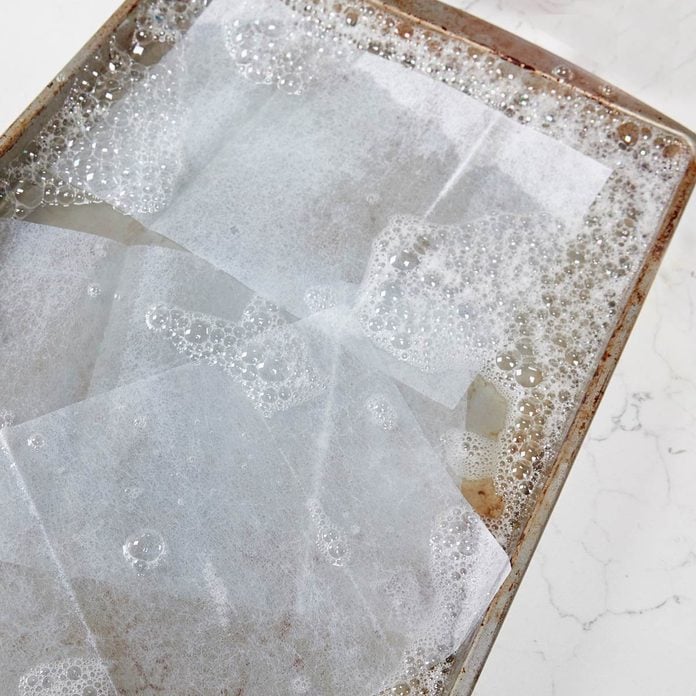 Family Handyman
Family Handyman
Easiest Way to Clean a Burnt Pan
Have you ever cooked something and totally scorched the pan? The burnt remnants seem impossible to clean. Here's one kitchen hack that will make it easier to swipe away the burnt-on grime: fill the pan with hot water, then add a little dish soap and a couple dryer sheets. Let it sit for an hour and wipe clean with a scrubbing pad.
Note: Once you're done cleaning with the dryer sheet, use soap and water to wash the pan as usual.
2 / 28

Permanent Marker on Dry Erase Board
Who hasn't accidentally written on a white board with a permanent marker? Luckily, it's easier to remove than you think. Simply draw over your permanent marker artwork with a dry erase marker, and then wipe the marks away with an eraser or dry cloth. Your dry erase board will be good as new!
3 / 28
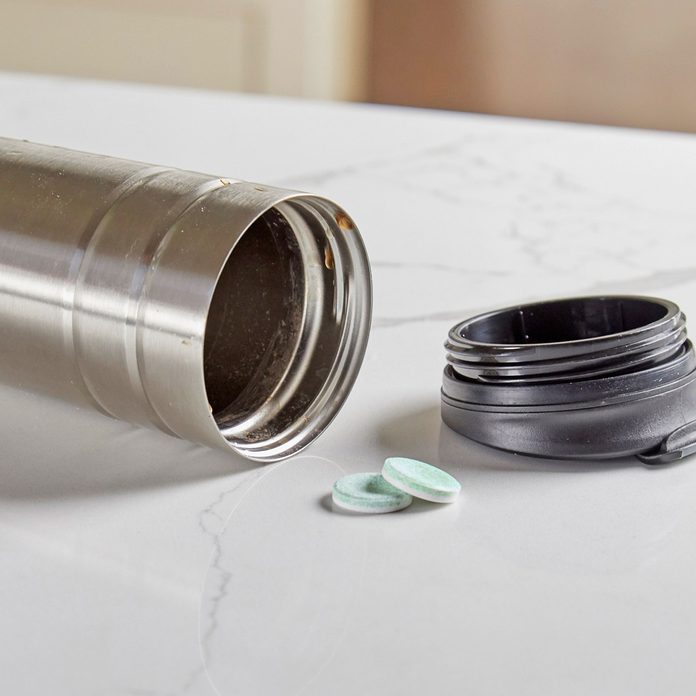 Family Handyman
Family Handyman
Remove Tough Stains from a Coffee Thermos
Got stubborn coffee stains on a pot, thermos or mug? Denture cleaner is the best cleaner we've ever found for these tough stains. Dissolve one denture cleaning tablet per two cups of hot water. Pour it in the stained vessel and let it sit for several hours and then use a scrub brush to clean off the stains and all the loosened bits. Pour the solution out and rinse thoroughly.
4 / 28
 Family Handyman
Family Handyman
Get Gum Out of Carpet
When gum freezes, it gets brittle and easily breaks apart. So, if you have gum stuck in your carpet, freeze it. Place a sandwich bag filled with ice cubes on top of the gum and wait about a half hour. When the gum is frozen, break it apart and pull it out of the carpet. No trace left behind.
Plus, we've rounded up 14 common annoying sights and come up with the best DIY fixes to make them right with little effort and minimal cost.
6 / 28
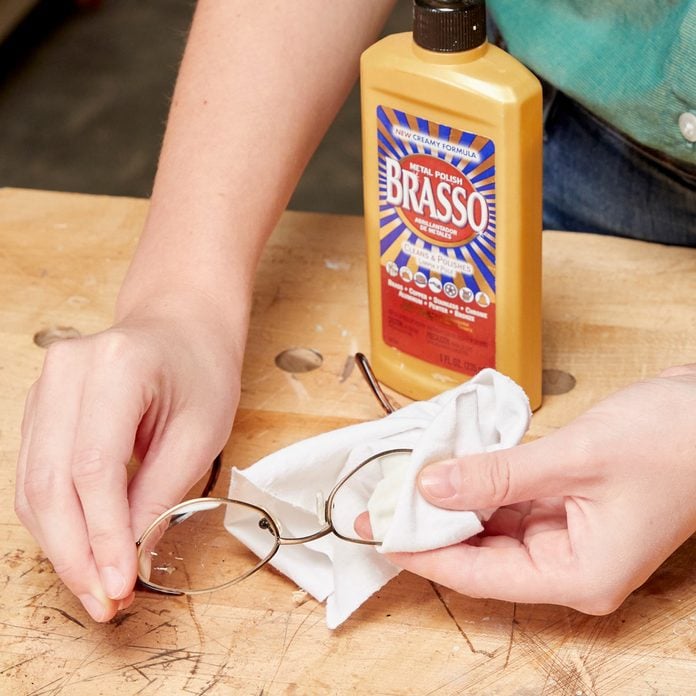 Family Handyman
Family Handyman
Scratch-Free Glasses
Scratched eyeglasses are a real nuisance and make it hard to see. If your glasses DON'T have antiglare or scratch coating on them, here's how to get minor scratches out. Put a drop of Brasso on a 100 percent cotton cloth, the softer the better. Apply the product to the lenses, let it dry completely, and then polish out the scratches.
7 / 28
 Family Handyman
Family Handyman
Spilled paint on your carpet? Don't panic, do this:
One of our readers, Tom Gerdowsky, shared this tip for removing paint from carpet:
"I used to think dropping a loaded paintbrush on the carpet meant replacing the carpet until a former foreman told me this little tip. Pour some denatured alcohol onto a rag and scrub away the paint. Use a rag that is as close in color to the carpet, as the alcohol can transfer some of the rag's color to the carpet."
Need some denatured alcohol? Buy it from Amazon here
8 / 28
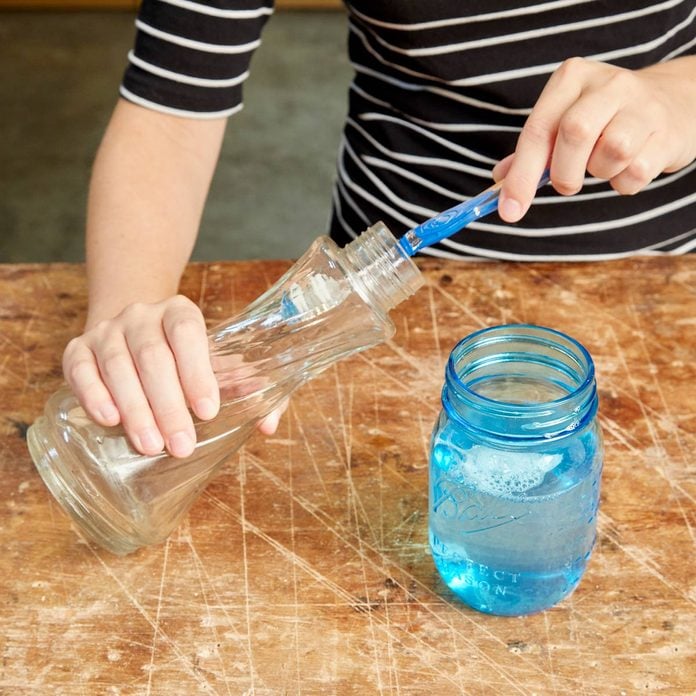 Family Handyman
Family Handyman
Clean Hard-to-Reach Spots
If you own a hummingbird feeder or tall flower vase, you know how difficult it is to clean inside them. A toothbrush is perfect for cleaning those hard-to-reach places. So, when your old toothbrush has retired from duty in your mouth, give it a new job!
Check out these secret cleaning tips from the pros.
9 / 28
 Family Handyman
Family Handyman
Remove Crayon Marks From Walls
Have your walls been redecorated with some original crayon masterpieces? Don't lose your cool. Just grab a rag, dip it in some baking soda and lightly scrub the marks. They will come off with a minimal amount of effort and give your young Picasso a fresh, new canvas.
Dealing with other types of stains? We have solutions for you!
10 / 28

How to Clean Off Sticker Residue
Reach for cooking oil next time you want to remove annoying sticker residue. Dab any type of kitchen cooking oil—olive, canola or sunflower—onto a paper towel. Then lay the paper towel over the residue that refuses to budge. Wait a few minutes while the oil works to dissolve the stubborn glue. Finally, remove the towel and rub away the sticker residue with another clean paper towel.
A degree of caution is necessary when using this cooking oil method. This is because many oils can stain absorbent materials like clothing. If you are concerned about leaving a stain, test a drop of your chosen oil on an inconspicuous part of the object. And proceed only if the oil leaves no trace to remove glue residue.
11 / 28
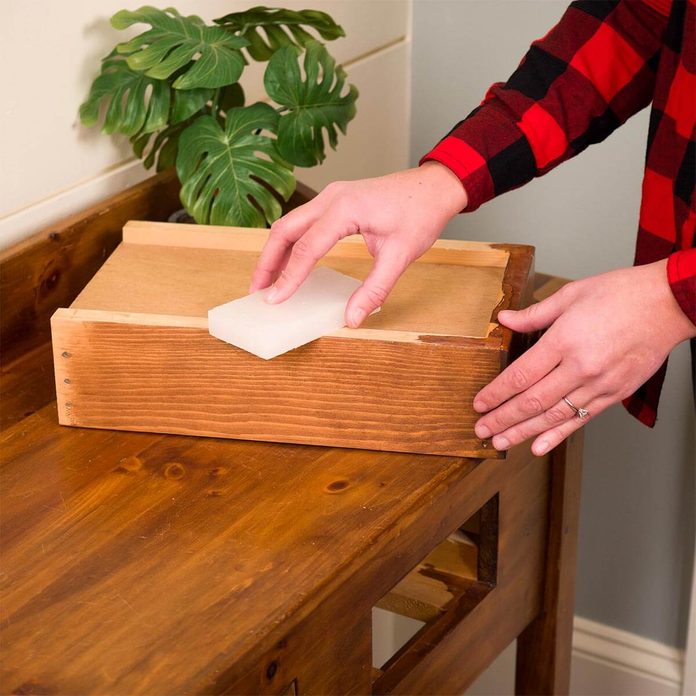 Family Handyman
Family Handyman
Gulf Wax for Stuck Drawers
Wooden drawers with wooden drawer slides often become sticky and difficult to open and close. Moisture is usually the culprit, making the wood swell or warp slightly and causing too much friction. A sticky drawer can be very frustrating, especially if you use it frequently.
Try this quick fix: Rub a block of Gulf Wax along the wooden drawer slides and along any other high-friction points on the drawers. Gulf Wax is a household paraffin wax, commonly used for canning and making candles. The gulf wax will lubricate the moving parts and make the drawers operate much more smoothly.
12 / 28
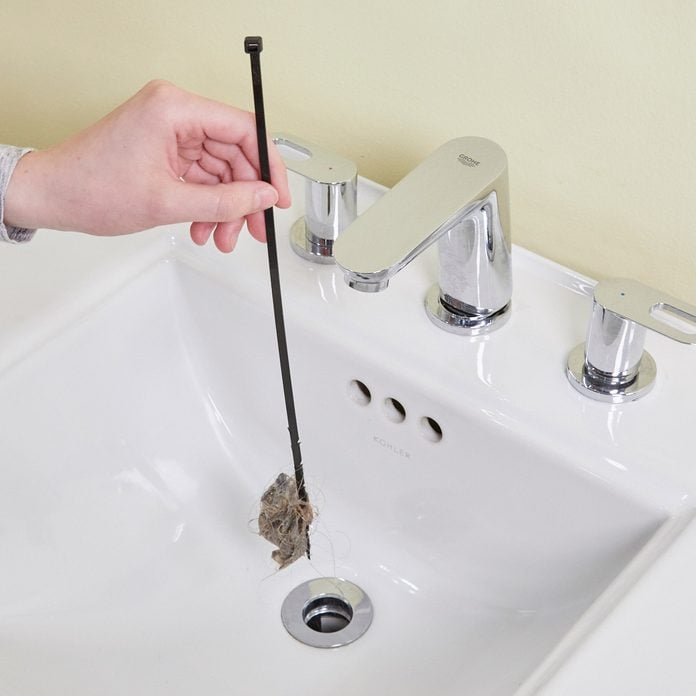 Family Handyman
Family Handyman
Zip-Tie to the Rescue
When my bathroom sink gets clogged, I don't reach for chemicals as a bathroom sink cleaner. Instead, I use a long zip tie. I cut several notches on the zip-tie's end. It'll hook the hair clog, allowing you to pull it out. Problem solved. The size of the eye of the zip tie prevented me from inadvertently pushing the tie past the stopper. — Rick Holmen
Every homeowner should have a stash of these tiny, versatile straps on hand. Zip ties can help you conquer clutter, work hands-free and even see in the dark.
13 / 28
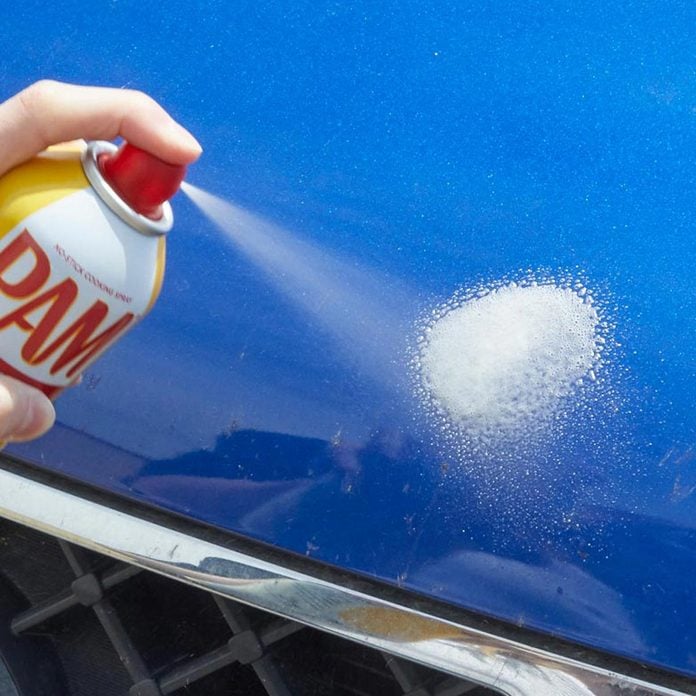
Get Rid of Bug Splatters
When you drive a long enough distance you're going to end up with bug splatters on the front of your car. The bugs are impossible to avoid and if you leave them on your car for too long, they will harden and will become difficult to remove. Unfortunately, cleaning the bugs off of your car requires a little more than just a quick car wash. So instead of scrubbing and potentially damaging your car's paint job, grab a can of cooking spray. Spray a bit onto the stubborn bug, wait a few seconds, then use a microfiber cloth to wipe the area clean. Be sure to wash the area clean with soap and water like you would when giving your vehicle a car wash.
Check out the best car cleaning tips and tricks to get your vehicle looking good as new!
14 / 28
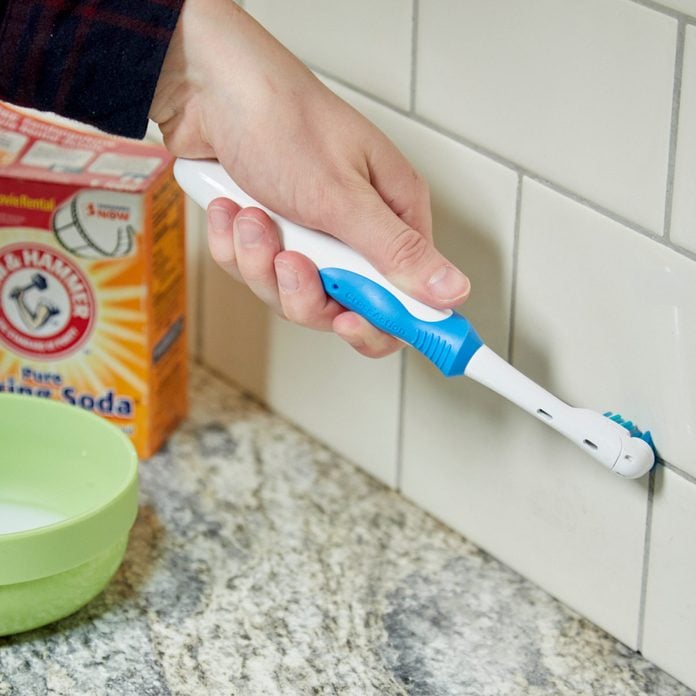 Family Handyman
Family Handyman
Clean More Than Just Your Teeth!
Here's what one of our readers, Ellis Biderson, had to say about the versatility of the electric toothbrush:
"One of the handy little tools that I use for cleaning around the house is an electric toothbrush. To clean up residue and splatters in the kitchen, I use just a bit of baking soda under the spinning toothbrush head to quickly clean the metal sink and plastic dish drying rack. I also use the electric toothbrush with baking soda and a tiny bit of water to scrub grout in both the kitchen and bathroom. Of course, I use a different one for my teeth!"
15 / 28

Retrieve Items Dropped Down Drains
Small and sometimes expensive items are easily washed down the sink drain. And if the item you dropped down the drain is metal like a drywall screw or washer, a simple magnet might be just what you need to retrieve the item.
Try attaching a magnet that is small enough to fit down your drain on the end of a long string or small, flexible rod that will also fit down your drain. Lower the magnet and slowly pull it back up in order to ensure you don't drop the item once again. If you're still without your favorite piece of jewelry, try a stronger rare earth magnet and see if that does the trick.
16 / 28
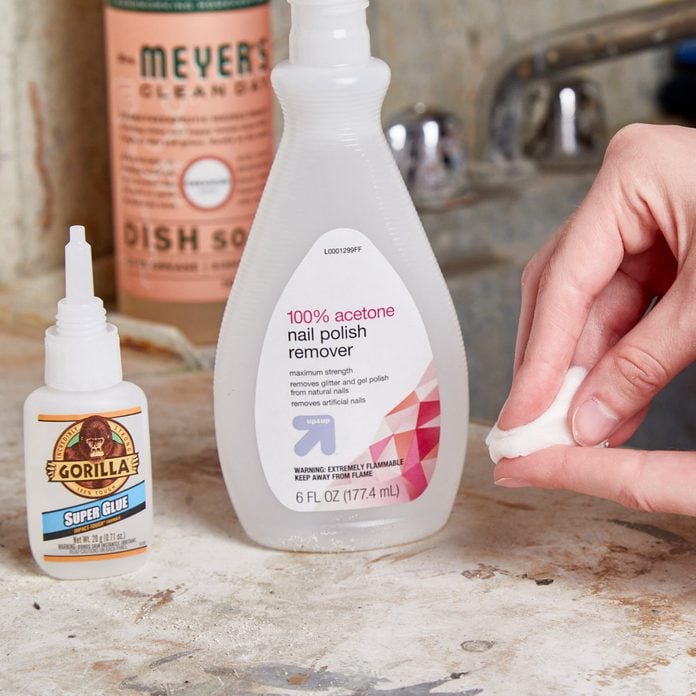
Easy Super Glue Removal
Removing super glue is a hassle but if you act quickly you can reduce how long you're stuck to yourself or the item you're gluing. Soak the glue spot in warm soapy water as soon as possible to soften the glue, and then pat dry. Rub the glue with an acetone-based nail polish remover. And make sure the nail polish remover you use contains acetone. Acetone is the ingredient that will breakdown the adhesive agents of super glue. The glue will turn white and easily peel off.
See what else nail polish remover can get rid of around the house.
17 / 28

Get Rid of Glue Squeeze-Out
When glue squeezes out on an inside corner like in a drawer or the inside of any woodworking project, using a chisel has the potential to cause more harm than good. This is because the sharp blade can easily mark-up and scratch the adjacent surface. The solution is a simple drinking straw. We used paper straws because they can be recycled, unlike plastic ones. The straw will conform to the shape of the corner and the excess glue will be collected inside the straw so it can't get re-deposited anywhere else.
18 / 28
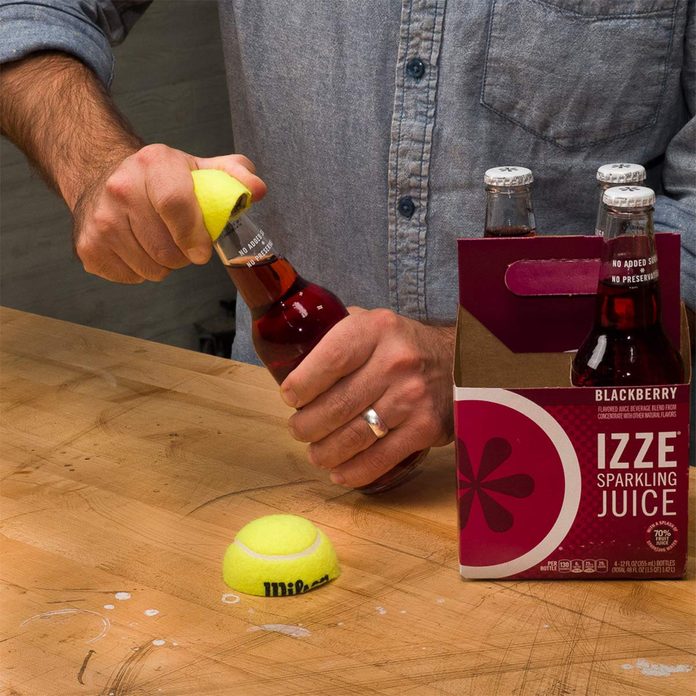
Tennis Ball Bottle Opener
The rubbery interior of a tennis ball makes it perfect for gripping stubborn twist-off bottle caps or sticky jar lids. And the soft exterior eases the strain on your hands when bearing down on the item you're trying to open.
To make this handy bottle and jar opener, use a utility knife to cut a tennis ball in half. For safety, stabilize the tennis ball in a vise or clamp it to a work surface while cutting, so it doesn't move around. With one tennis ball, you can create two openers—one for your kitchen and one for your home bar area.
19 / 28
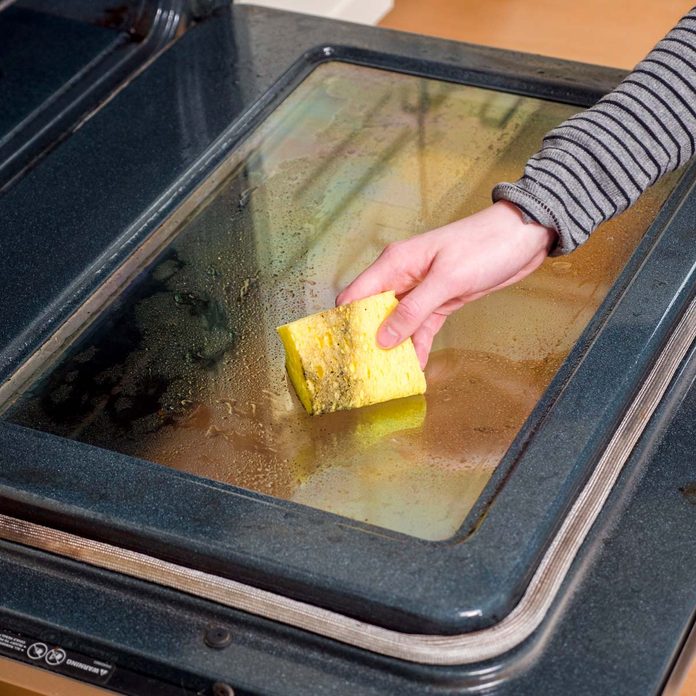
Steam for Everyday Spills
The advantages of traditional oven cleaners are power and speed. But for many of us, the disadvantages outweigh the good, specifically, the corrosive chemicals and caustic fumes that this type of oven cleaning can produce.
A simple, more natural way for cleaning your oven is to place an oven-safe pot or bowl filled with water inside. Set your oven to 450 degrees for 20 to 60 minutes to loosen dirt and grease with the steam. Once your oven is cool, wipe off the condensation and the grease will come with it. If stubborn spots persist, scrub with a paste of baking soda and lemon or vinegar. This steam-cleaning option doesn't take as long as pyrolytic cleaning and doesn't produce smoke, either. It's a win-win! Plus: If your kitchen sponge smells funky, here's how to clean it.
20 / 28
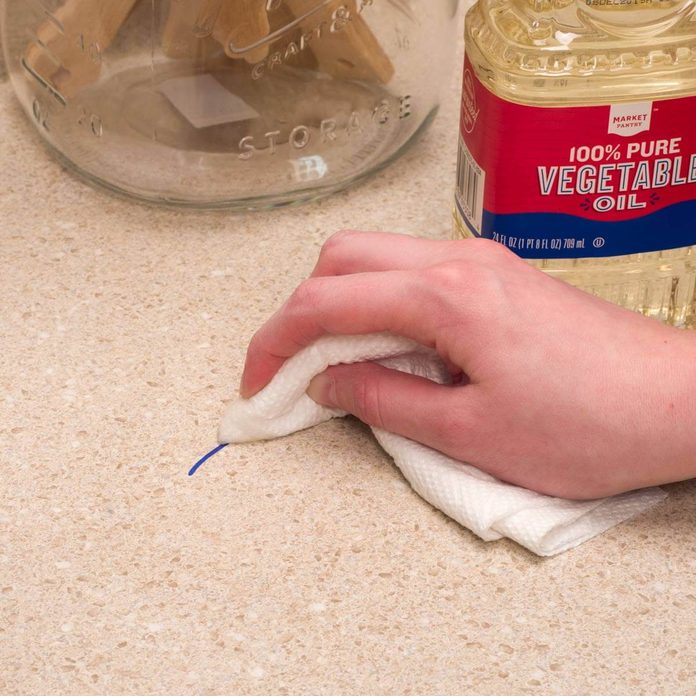 Family Handyman
Family Handyman
Remove Permanent Marker on Laminate
Dab some cooking oil onto a paper towel and then lay the paper towel over the stain that refuses to budge. Wait a few minutes while the oil works to dissolve the stubborn stain. Finally, remove the towel and rub away the stain in circular motions (with some force) with another paper towel dipped in oil. When the stain is gone, wipe the area clean with soap and water.
21 / 28
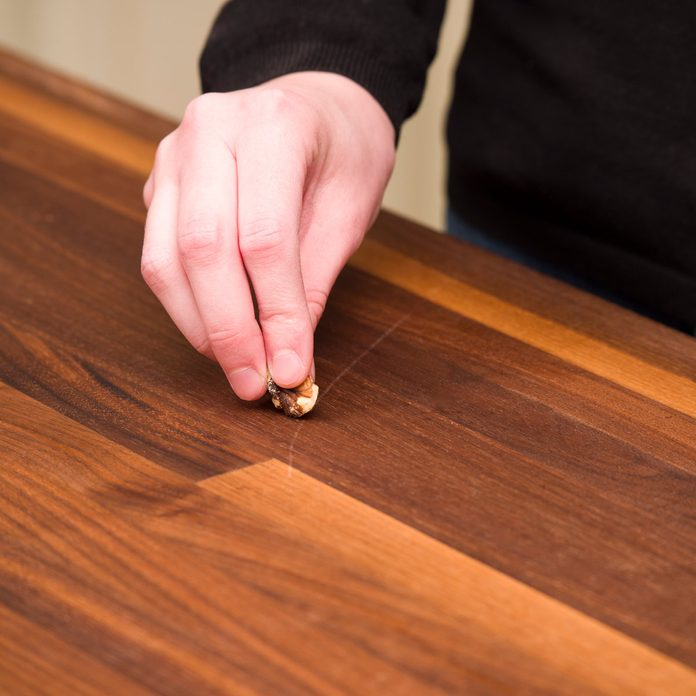
Fix Wood Scratches
Simply rub a walnut over a scratch in wood several times. Then, with your fingers rub the scratched area. This will help the wood absorb the oil from the nut. Lastly, use a soft cloth to buff the area. Now the scratch is sealed and gone!
This handy hint works on light scratches and not deep gouges in wood, however, we do have a solution for this issue as well!
22 / 28

How to Get Dents Out of Wood
Soak a washcloth in water and ring it out a bit so it's not sopping wet. Put the damp washcloth on the affected area. The water will wick through the wood, and that's fine. Now, with your iron on its highest setting, place it on the damp washcloth over the affected area, and make small movements back and forth and in circles. Press down firmly and continue until your washcloth is dry. It won't take long to evaporate. At this point, the wood fibers are absorbing the water and should expand back to where they were originally. Continue this process and repeat by adding more water until the dents rise up to be flush with the rest of the material.
23 / 28
 Family Handyman
Family Handyman
Clean a Cast Iron Skillet
To prevent rust and extend the life of a cast iron skillet, it's bestnot to use soap to clean it. Instead, use about a tablespoon of coarse salt to scrub the pan after a meal.
The salt breaks up bits of stuck food and residue on the skillet. Then toss the dirty salt in the trash, rinse the pan with hot water and dry it with a clean towel. To further protect a cast iron skillet, rub a few drops of vegetable oil over the entire cooking surface. Check out more of our favorite cleaning tips.
24 / 28
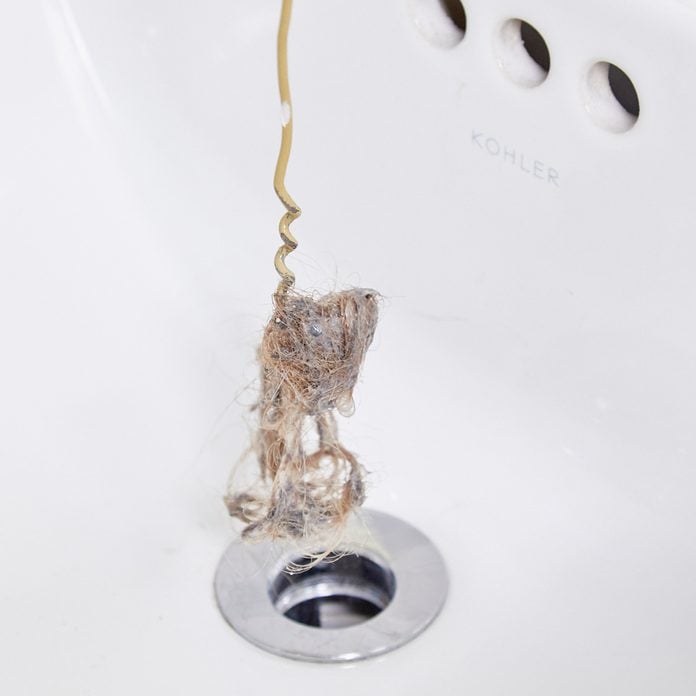
Clothes Hanger Drain Cleaner
Hair clumps that get stuck in the drain are inevitable. Turns out, a wire coat hanger is the one of the most effective tools for unclogging them. First, untwist the wire under the hook. This leaves the hook at one end and a miniature "auger" at the other end. Push the auger end down the drain up to the clog. Bend the free end 90 degrees, forming a handle. Crank the handle so the auger bores into the clog, allowing you to pull it out.
25 / 28
 Family Handyman
Family Handyman
Remove Hard-Water Buildup with a Lemon
To get rid of hard-water buildup on a faucet, try this natural solution: Cut a fresh lemon in half. With one of the halves, use your thumbs to gently open up the center. Then press the lemon onto the end of the faucet. Put a small plastic bag around the lemon and secure it around the faucet with a rubber band. Be sure that the rubber band it cinched tightly and that the lemon is around the end of the faucet. Leave the lemon in place for a few hours to allow the citric acid to work its magic.
After you remove the lemon, you may need to use a gentle scrubbing pad to wash off any loosened hard-water buildup. Then wipe the faucet with a damp cloth to remove any leftover lemon juice, and your faucet will be squeaky clean
26 / 28
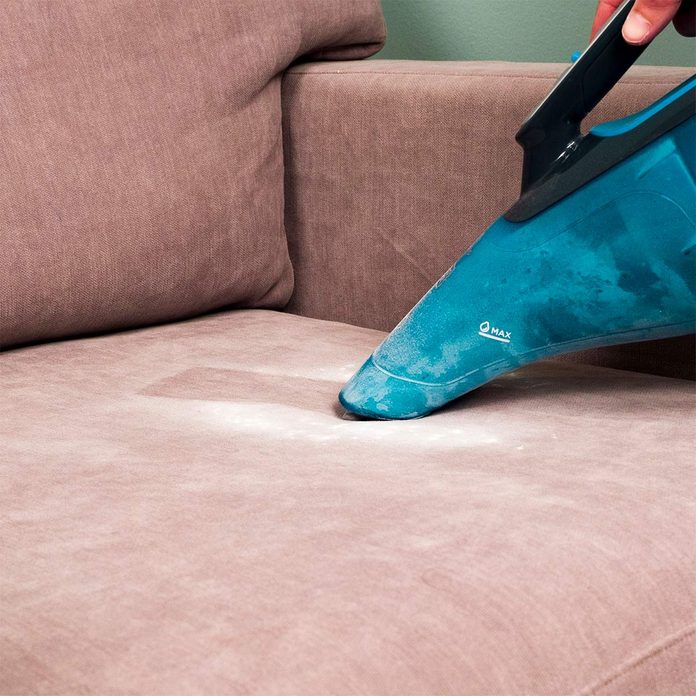
Clean Upholstery
Use this handy hint if there's a funky smell lurking in your couch or upholstered chair: Sprinkle a generous amount of regular baking soda onto the fabric and let it sit for at least 20 minutes. The baking soda will help to release odors and break up some light stains in the fabric. After about 20 minutes, remove the baking soda—and the funky smell—with a handheld vacuum or a hose attachment for your large vacuum.
27 / 28
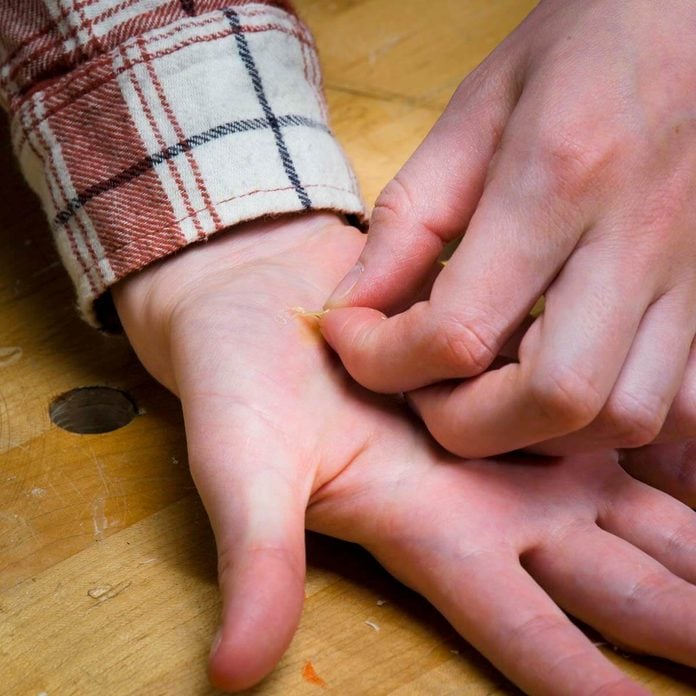
Splinter Extraction
Have you ever struggled to get a splinter out of a finger or toe? It can be a challenge, not to mention a pain. Spread a small amount of wood glue over the affected area and let dry completely. When you pull off the dried glue (gently and in the opposite direction of the splinter) it pulls out the splinter. By pulling the wood glue off in the opposite direction, the glue has a chance to pull the splinter out the way it went in. This tip is easy and most importantly pain-free!
Now that you know this handy glue tip, check out these 45 brilliant gluing tips and tricks.
28 / 28
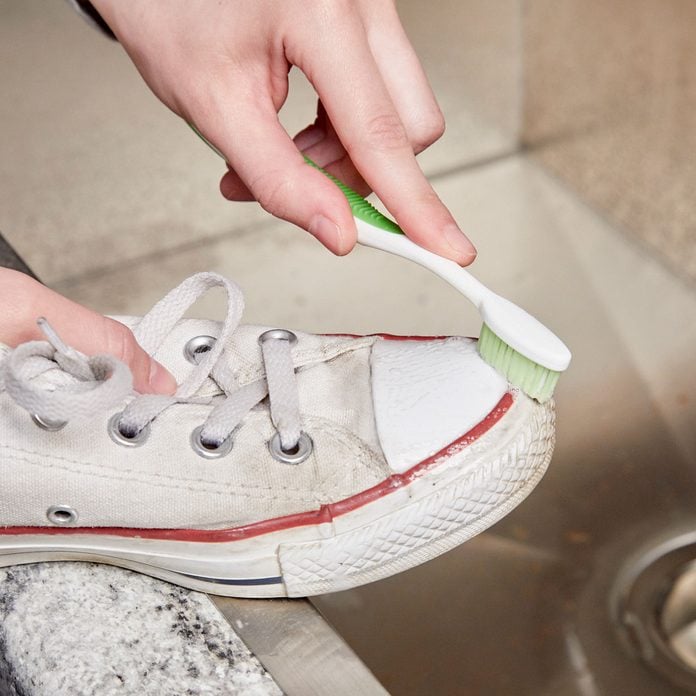 Family Handyman
Family Handyman
Use Toothpaste to Clean Sneakers
All you need is an old toothbrush and a little toothpaste to learn how to clean sneakers and get your old sneakers looking like new! Non-gel white toothpaste works great for cleaning white-soled sneakers (colored toothpaste may stain sneakers). Apply toothpaste to an old toothbrush and then work the paste into the dirty spots. Leave the toothpaste on the shoes for about ten minutes, and then wipe it off with a damp towel. Repeat the process if necessary.
Important: The ingredients in toothpaste may vary from brand to brand, so make sure to try this method on a small unnoticeable spot on your sneakers before applying it to the rest of the shoe.
Toothpaste will keep your smile in great shape but it's also pretty handy in cleaning up around the house.
Every product is independently selected by our editors. If you buy something through our links, we may earn an affiliate commission.
Originally Published: January 27, 2020
Sign up for DIY projects sent right to your inbox
Complete DIY projects like a pro! Sign up for our newsletter!

Subscribe & SAVE 1 Year Subscription
for only $10!
How To Clean Up Exploded Stress Ball
Source: https://www.familyhandyman.com/list/28-handy-hints-for-removing-hard-to-remove-stuff/
Posted by: coonscriniveran.blogspot.com

0 Response to "How To Clean Up Exploded Stress Ball"
Post a Comment